Abstract
Creative imagination is inextricably connected and influenced, as we believe, by the empathetic side. As a consequence, empathy would be an interesting form of intuiting reality through the affective-emotional identification. Through the study of the influence of Physical Education in the development of the creative-empathetic potential on students, the researcher intends to emphasize that, between creativity and empathy, there are unseen connections that influence a human being, for both the cognitive and the emotional levels, within the development of the entire creative-empathetic spectrum. This research was conducted during Physical Education classes, on a group of 75 students, randomly chosen from the Science and Letters Faculty of the researcher’s university. A 30-item questionnaire on “The evaluation of the creative-empathetic potential”, was distributed to the sample. The data obtained from the questionnaire was aimed at answering the question “Are there significant differences within the recorded results so to prove that Physical Education is a motor of changes in the students’ creative-empathetic development?” The aim of this research was to emphasize that Physical Education plays a decisive role in the academic program for the students’ creative-empathetic development and the creative-empathetic potential is adversely affected when the number of Physical Education classes decreases or when students are absent from classes for various reasons (absent, any exemptions etc.). The emotional component is considered to be the heart of empathy. Hence, it is contended that in the absence of certain emotions, the creativity field (anxiety) is impeded, and it can be concluded that neither empathy nor creativity can be designed to manifest outside emotiveness and intelligence, both with the chance of being developed through common instruments, namely through Physical Education and Sport.
Keywords: Creativityempathyphysical educationstudents
Introduction
“Creative imagination is the most valuable and complex form of the active and
voluntary imagination” (Popescu-Neveanu, et al., 1990) inextricably connected and
influenced, by the empathetic side. “In everyday life, we usually encounter numerous types
of problems related directly to our personal issues, such as emotional and social relationships
together with our professional careers” (Serra, & Ermiş, 2017). Through the study of the
influence of Physical Education in the development of the creative-empathetic potential on
students, this study aims to emphasize that there are unseen connections between creativity
and empathy that influence a human being, at both the cognitive and the emotional levels,
within the development of the entire spectrum of creative-empathetic potential. This is
because creativity, being a high form of imagination, cannot be simply reduced to the
manner of transforming and combining certain sequences. If empathy were added to all of
the aforementioned, which is nothing more than an interesting form of intuiting reality
through affective-emotional identification, then it is possible to have a complete image
regarding the phase of changes in the life of young people through the impact of Physical
Education, both on the emotional and on the psychological-motor levels.
Hypothesis
This research originated from the hypothesis that Physical Education with all its
practical and theoretical-applied content can be the motor of the creative empathetic-
development. It is believed that decreasing the number of classes (as it happened in the
previous years) or the exemption from classes of some students for various reasons (medical
exemptions, etc.) would cause serious negative repercussions on both the creative and
empathetic levels.
Methods
Subjects
This research was conducted during Physical Education classes on a group of 75
students randomly chosen from the Science and Letters Faculty of the researcher’s
university, who, at least theoretically, have the same social concerns.
Research methods
Several methods were employed for this study which was based on a mixed method
design, comprising the bibliographic study method (the reasons taken into consideration for
the determination of the research hypothesis came from the reference literature and from the
experience gained in the didactic process); the observation method (comprising the
systematic observation of motric actions, and practical-theoretical-applied actions of the
subjects), and the survey method (for which the conversation and the questionnaire was
used). At the pre-investigation stage, the theme, selection of study subjects, and
questionnaire were determined. The questionnaire selected for this study has already been
standardized, which allowed the phenomenon to be rendered more accurately. The selected
questionnaire was proposed by Cristina Pavelea & collaborators (2005, p.88-90) and the
original title of this 30-item questionnaire was: “The creative-empathetic potential”. This
questionnaire had been distributed to parents, educators, and primary school teachers by the
original authors. In the context of this study, the only difference in application concerned the
group on which the questionnaire was implemented, which in this case, referred directly to
the target group - the group of 75 students, randomly chosen from the Science and Letters
Faculty of the researcher’s university, who, at least theoretically, have the same social
concerns. In this study, no observations was done through intermediaries (parents, teachers,
etc.). In other words, efforts were made to render reality as accurately as possible. The
statistical-mathematical method allowed the description and characterization on digital
objective bases, of the different data that represented the measured indicators and favored the
extraction of the essence regarding the theme/s from a data set. The graphical method
referred to a system of rules which were followed for the purpose of visualizing and
suggestively presenting calculated figures, data and indicators.
Research purpose
The purpose of the present research was to present empirical evidence that Physical
Education plays a decisive role in academic programs for students’ creative-empathetic
development and that creative-empathetic potential is adversely affected when the number of
Physical Education classes decreases or when students do not participate in these classes for
various reasons (absent, exemptions etc.).
Research content
In order to demonstrate that Physical Education can be the engine of creative-
empathetic development in young people and that the absence of this subject in school life or
from the university programs would cause negative repercussions at both creative and
empathetic levels, a questionnaire entitled: “The creative-empathetic potential” was
distributed to the study group. This questionnaire was adapted from “The evaluation of the
creative and empathetic potential of the preschool and primary school pupils” (Pavelea et al.,
2005). In the case of this study, the questionnaire was distributed only to the target group
comprising the students and no observations was done through intermediaries such as
parents, teachers, etc. as was the case with the original questionnaire. All efforts were made
to render reality as accurately as possible as the researcher believed that a direct
implementation on the subjects involved in the research was sufficient and “third parties”
opinions’ were unnecessary in the context of this study.
In order to obtain the correct information concerning the motor of the creative-
empathetic development, regarding the targeted group, a rethinking of the questionnaire was
deemed necessary as the questionnaire was applied directly to the study subjects to respond
to the questions in the questionnaire, in order to correspond to the research undertaken, and
the education and age of the group of subjects involved in our research. For the
implementation of the questionnaire, all the conditions imposed by the research methodology
regarding the implementation of the questionnaire were adhered to and the subjects’ attention
was directed to need to render faithfully the events by “deeply searching in time”, to recall
how they reacted when they were children.
The study subjects’ were reminded that honesty was crucial in responding to the
questionnaire, as there were no good or bad results, “but the confirmation or information of
ways“ (Pavelea et al., 2005) of acting in certain situations in their childhood. The honest
answers were necessary only from an objective point of view, as “for determining the
creative-empathetic potential we needed answers as close to reality as possible” (Pavelea et
al., 2005), according to Table 01 below.
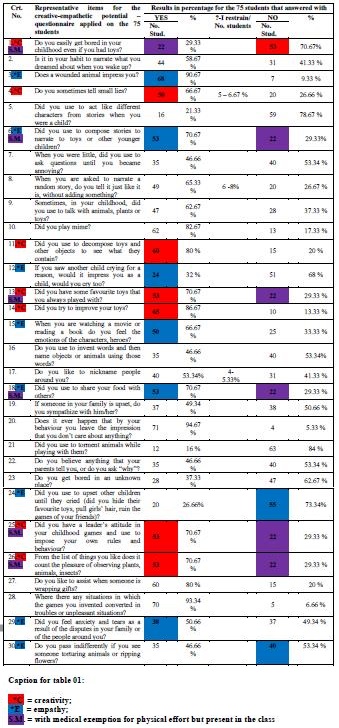
The research was based on a 30-item questionnaire with the theme “Creative-
empathetic potential” (Table 01). By adding the number of students who answered “YES” to
the ones who answered “NO” to each one of the items in Table 01, the total number of
students (75) and the manner in which they ticked the answers for each question in
percentage were generated. The questionnaire aimed to measure the creative-empathetic
potential in percentage for each student. Responses were ticked by choosing
research, marked with a star *, a symbol and a color according to the table caption. These
items 1, 4, 11, 13, 14, 25, 26 tested for Creativity; 3, 6, 12, 15, 18, 24, 29, 30 tested for
Empathy; while for those who have a medical exemption, Creativity was tested through their
answers to items 1, 13, 25, 26 and Empathy was tested through their response to items 6 and
18.For the recognition indicators, students were asked to specify: age, gender, if they are fit
or have a medical exemption, if they have been participating in any sports, and if so, starting
at what age, etc. This aided in grouping them and discovering the type of potential and the
conditions that determine it. All these aspects aided in identifying divisions and analyzing
the typology.
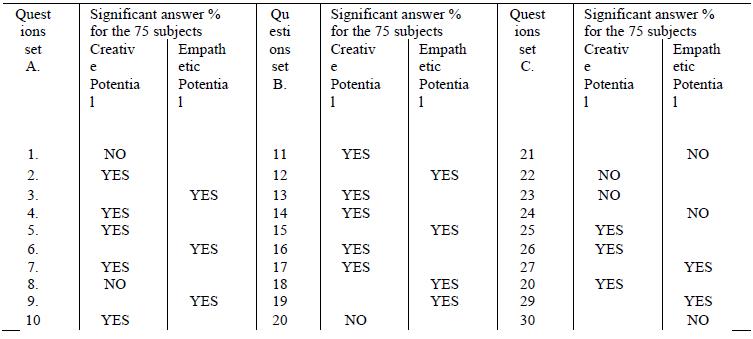
Responses to the questionnaire listing the Table 01 was carried out according to the
data in Table 02.This table was divided into 10 sets of questions, as it can be seen in Table
02 (set A; set B; set C) summing up the 30 items of the questionnaire.
Every relevant answer represents a point; if the answer corresponded to the standard
Table 02 (for answers, also see Table 03 below, with a total score), if the answer did not
correspond to the answer for the question in the standard Table 02, then students received 0
points.
After that, the number of points was calculated for creativity and empathy after a
standard table taken from Pavelea et al.’s work (2005, p. 89). An important point to note is
that points were validated only if answers matched the standard Table 02.
A. Set - contains items from 1 to 10 (in this set, items 1, 2, 4, 5, 7, 8, 10 were considered
significant answers for creativity and answers to items 3, 6, 9 were considered significant
answers for empathy).
�For Empathy
• students who responded with “Yes”to items
correct answer.
• students who responded with “No” to items 1, 8 received one point for each correct
answer.
• In situations where the students’ answers were different from the standard response in
Table 02, 0 points were recorded for each different answer.
�For Creativity
• students who responded “Yes” to items 3, 6, 9 received one point for each correct answer.
B. Set - contains items from 11 to 20 (in this set items 11, 13, 14, 16, 17, 20 were
considered significant answers for creativity and items 12, 15, 18, 19 were considered
significant answers for empathy).
�For Empathy
• students who responded with “Yes” to items 11, 13, 14, 17 received one point for each
correct answer.
• those who responded “ No” to item 20 received one point for the correct answer.
�For Creativity
• those who responded “Yes” to items 12, 15, 18, 19 received one point for each correct
answer.
C. Set - contains items from 21 to 30 (in this set, items 22, 23, 25, 26, 28 were significant
answers for creativity and items 21, 24, 27, 29, 30 were significant answers for empathy)
�For Empathy
• those who responded “Yes” to items 25, 26, 28 received one point for each correct answer.
• those who responded “No” to items 22, 23 received one point for each correct answer.
�For Creativity
• those who responded “Yes” to items 27, 29 received one point for each correct answer.
• those who responded “No” to the item 21, 24, 30 received one point for each correct
answer.

If students’ recorded answers were different than the standard answers from the Table
02, then they scored 0 points for each answer.
In the end, a total was calculated on the creative – empathetic potential, for points
recorded separately for each component (creative or empathetic).
The recorded score was compared with the one from standard Table 0 and a grade
was given, and depending on the obtained score, the creative-empathetic potential was
validated.
The interpretation of the creative potential level, taking into account the above
mentioned, was estimated according to the score obtained using the standard Table 03 above.
Findings and Discussion
In the questionnaire (see Table 01), items were logically organized in such way as to
uncover the reality regarding the main factor – The Creative-Empathetic potential.
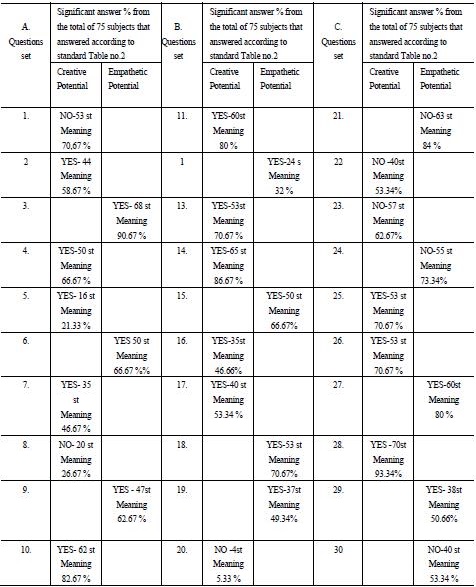
Three sets were made, each containing 10 items as described above. Some of the
items were marked with stars as they represented relevant questions for this research. Table
04 renders, according to standard requests, statistical indicators for the creative-empathetic
potential in percentage (%) for all the 75 subjects who participated in this experiment.
Not all subjects registered similar answers resulting in the appearance of significant
differences. The reason is that the number of students who responded with, “Yes” or “No”
differs from the number of subjects who took part in the research and helped to generate
specific information about the creative- empathetic potential (see Table 04 which is relevant
for this research).
It is important to note (in Table 04, students was abbrievated to st. due to space
constraints). Following the recorded data in the two tables and the survey conducted for the
75 study subjects, a difference between the groups (Table 04) was observed as follows:
- A group of 53 students or 70.67% are fit for exercise;
- Another group of 22 students or 29.33% have medical exemption from physical
exercise (S.M.).
Of the 53 students in the group who are fit for exercise, two other groups appear,
which was quite interesting for this research, namely:
- 20 students or 29.33% of the total used to participate in sports in the age range of 5-
14 years
- 33 students or 44% of the total regularly participated in Physical Education classes.

If a parallel is drawn between Empathy and Creativity based on several theoretical
and practical aspects which posit a link between these two concepts, their interrelation in the
personality and behavioral plan can be deduced.
From Tables 01 and 02, questions about creativity and also empathy arise.
The items in the questionnaire that provided answers for this research in terms of
creativity for people who are fit for physical effort, were items 1, 4, 11, 13, 14, 25 and 26,
while empathy the relevant percentages and responses came from items 3, 6, 12, 15, 18, 24,
29, 30.
After analyzing the questionnaire responses for creativity, we observed the following:
• for items 1, 13, 25, 26, the same number of respondents, 53 or 70.67% of the total
were recorded;
• for item 4, 50 subjects or 66.67% were recorded;
• for item 11, 60 subjects or 80% were recorded;
• for item 14 and last of the relevant items with an asterisk, 65 subjects or 66.67% of
the total were recorded.
The analysis of Table 04, which refers to the typology of subjects in research,
uncovered a surprising phenomenon, namely the number of subjects, who displayed
creativity (53 students = 70.67%), is identical to the number of subjects that are fit for
physical effort (all 53 students = 70.67%).
The number registered small variations for items 4, 11, 14.
As a result of this phenomenon, each item and discovered that indeed students who
responsded according to the standard table are those who are fit for physical effort, and to
this number of students a limited, almost insignificant number of students from the group
containing subjects with medical exemption could be added. Events continued to be observed
at this point.
The responses that corresponded to the empathy potential were observed and a similar
phenomenon to the one described above appeared, with few exceptions:
• for item 3, 68 subjects or 26.67% were recorded;
• for item 12 “If you saw a child crying for a reason in your childhood, would he/she
total were recorded. A more accurate verification revealed that 20 of the subjects
were part of the group that used to practice sports in their childhood.
This aspect modified the researcher’s perception of the group, and a new review of
the questionnaire was conducted where it was discovered that the 20 students who mentioned
that they used to practice sports as children, and who are a part of the group with subjects fit
for effort, are present in all the standard responses, and perfectly fit into the standard
typology created with the help of the questionnaire (empathetic and creative).
In this way, a conclusion was made that sports, especially a team sport practiced in
childhood, changes the manner in which subjects feel and express themselves, and creates an
increased level of empathy.
This is due to being part of a group and having a common purpose – victory for the
team – that people learn that emotions are precious, and a helping hand makes one more
human.
• a disheartening aspect was revealed in the responses to items 1, 6, 13, 18, 25, 26 (see
Table 01) where the same number of subjects registered each time, meaning 22 students or
29.33%, hence verifying the subjects’ answers in the questionnaire and recognition
indicators.
In order to elevate the applicability of the research, an interpretation of the creative-
empathetic potential level, taking into consideration the score obtained by each student.
Table no.3 was used and the scores obtained in Table no. 6were written within the section
of appreciating the creative-empathetic potential through grades.
At a more detailed research of the table within the section of appreciating the
creative-empathetic potential, subjects that participated at the research obtained the following
grades:
A. CREATIVE POTENTIAL
exemptions M.E.) - 5 were fit for effort);
exemptions (M.E.) – 26 were fit for effort);
•
and 20 who practiced sports in their childhood);
B. EMPATETHIC POTENTIAL
exemptions (M.E.);
exemptions (M.E.);
effort);
sports in their childhood);
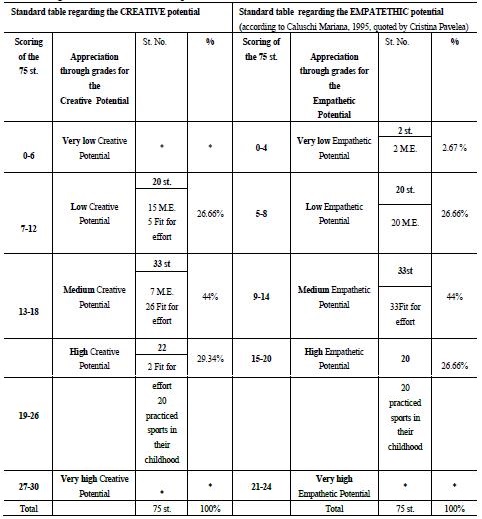
The data in Fig 01 and Table 06 show that students with medical exemptions scored 7
– 12 points and 13 – 18 points for creativity and empathy respectively and grades such as
“Low”, “Medium” and even “Very Low” for empathy. On the other hand, students fit for
effort and the ones who practiced sports in their childhood obtained superior grades. They
scored 13-18: 19-26 points for creativity, points that correspond for “Medium” and “High” grades.
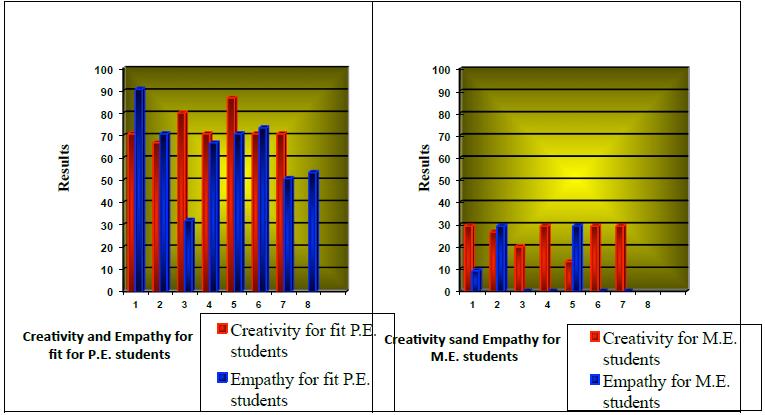
For
“High” grades.
These results confirm the hypothesis research that, for students, Physical Education
with all its practical and theoretical-applied content is the motor of the creative-empathetic
development, and for this reason, it is felt that decreasing the number of classes (as in the
case of recent years) or being absent from classes, for various reasons (absent or any
exemptions, etc.) causes serious negative repercussions (see Table 06, Graph
creative and empathetic levels. It is the contention of the researcher based on the results
obtained from the present research that physical exercise is a common form, without
implying major costs, of activating both creativity and empathy.
In both cases, the production mechanism of the two phenomena involved cognitive
stimulation, communication, responsiveness, affective, direct feeling, and intuition. As a
result of the observation in the case of empathy, subjective knowledge acquired during
physical activities practiced in a group, following well-established rules that cannot be
broken, and which can be tested and verified by the subjects’ behavior, results in a level of
accommodation of the individual to the social reality, known through respecting their leader,
the rules of the game, and so on. In the case of creativity, the creative product is verified in
practice - a game is invented, a nickname given, a character developed, other descriptions are
added and so on. Practice through play and sports can offer a verdict which is useful and
allows the subject to become famous, liked or even a leader. In both cases, it is the practice
that allows the subject to evolve and verify his/her value. In the case of this study, practice
is facilitated through physical activity, which allows each individual to stand face to face
with himself/herself, to confront his/her fear of being laughed at, but also to gain popularity
within the group.
It is wise to remember that empathy is, according to specialists, “the ability of being
"with" the other person and not "like" the other person”, and this, it is believed, enables
individualization in a group as a whole. In other words, while one may have their own
unique feelings, they are also the “group”, by participating in the collective emotion (see
Tables 04 and 05). As a result of the influence of physical activity through the mechanisms
that trigger them at a cognitive-creativity and affective-empathy levels, the individual's
ability to understand how he/she thinks, feels and acts with another personis positively
modified. It is crucial to remember this aspect, that empathy should not be confused with pity
or compassion for another person in difficulty. Empathy is nothing but an interesting form of
intuiting reality made through an affective-emotional identification. Thus, it helps build an
image of the changes that occur in different stages of youngsters on psychomotor, emotional
and creative levels, all of them being influenced by Physical Education. We believe that
there is no other learning activity such as Physical Education, in which the human body can
be stimulated on cognitive, affective and physical levels, as it is during all sports, Physical
Education classes or any other collective or individual sport. “All of these can become
objective in an original behavior that has the print of the one that knows empathy”. (Internet,
www.rasfiesc.com/businees/management/Empatie-sicreativitate-paralela57.php, 2016, p. 3).
As both processes are completed with a different product, different perceptions that may
exist or may annihilate empathy, is perhaps the most interesting feature of the human being –
the human side with excitement and the spark of geniality – creativity. In other words, it is
the researcher’s firm belief that the loss of empathy and creativity, would ultimately lead to
the destruction of humanity.
Conclusions
Physical Education plays a decisive role in the academic program in the students’
creative empathetic development. Between creativity and empathy there are invisible threads
that influence a human being at both cognitive and affective levels in developing the
empathetic-creative potential.
At a creative and empathetic level, the research reveals that exercise is a common
form, without implying major cost which plays an important role in activating the
individual’s creativity and empathy. In both cases, the production mechanism of the two
phenomena involves cognitive stimulation, communication, responsiveness, emotionality,
direct feeling, and intuition but especially motion.
As a result of the observation in the case of empathy, subjective knowledge acquired
during physical activities practiced in a group, following well established rules that cannot be
broken, and can be tested and verified by the subjects’ behavior, where a level of
accommodation of the individual to the social reality is achieved.
The analysis of the questionnaire confirm the hypothesis which states that, for
students, Physical Education with all its practical and theoretical-applied content can be the
motor of the creative empathetic-development. Hence, it is the researcher’s contention that
decreasing the number of classes (as has occurred in the last few years) or the exemption
from classes of some students for various reasons (distraction from classes, medical
exemptions, etc.) would cause serious negative repercussions for both the creative and
empathetic levels (see Table 05 and Graph
The emotional component is considered to be the heart of empathy, and the absence
of certain emotions results in a blockage in the creativity field (anxiety), where it can be
concluded that neither empathy nor creativity can be designed to manifest outside
emotiveness and intelligence. However, both may be developed through common
instruments, namely through Physical Education and Sport. This study leaves the path open
for other researchers to add new empirical evidence to this field.
References
- Amasay, T., Hall, G., Shapiro, S., Ludwig, K. (2016). The Relation between Scapular Dyskinesis and the Upper Quarter Y-Balance Test. In: International Journal of Anatomy & Applied Physiology, 2(2) 21-24 Borsa, PA., Laudner, KG., Sauers, EL. (2008). Mobility and Stability Adaptations in the Shoulder of the Overhead Athlete A Theoretical and Evidence-Based Perspective.
- In: Sport Medicine, 38(1), 2008, 17-36. doi: 10.2165/00007256-200838010-00003.17-36.
- Bota, A., (2006) Physical Exercises for an Active Life – Motor activities for Leisure Time, University Book Publishing House, Bucharest, 95-97; 99 -114.
- Colibaba, E.D. (2007). Praxiology and curricular project in Physical Education and Sports. Craiova: Universitaria Publishing House.
- Debreu, C. K. W., Baas, M., Nijstad, B. A. (2012). The emotive roots of creativity: Basic and applied issues on affect and motivation. In M. Mumford (Ed.), Handbook of organizational creativity . San Diego: Academic Press. (pp.217-240) Dragnea, A., &Bota, A.,(1999) Theory of motric activities. Didactic and Pedagogical Publishing House R.A., Bucharest.
- Epuran, M., (2005). The Methodology of Research for Body Activities. Physical Exercise. Sport. Fitness, Second Edition, Bucharest, FEST.
- Golu, M., (2002) Fundaments of psychology I,II, Romania of Tomorrow Publishing House, Bucharest.
- Gorman, PP., Butler, R.J., Plisky, PJ., Kiesel, KB. (2012). Upper Quarter Y Balance Test: reliability and performance comparison between genders in active adults. In: Journal of Strength and Conditioning Research, 26(11) doi: 10.1519/JSC.0b013e3182472fdb. Hazar, Z., Ulug, N., Yuksel, I., (2014). Upper Quarter Y-Balance Test Score of Patients with Shoulder Impingement Syndrome. In: Orthopaedic Journal of Sports Medicine 2014 Nov; 2(3 Suppl): doi: 10.1177/2325967114S00275 Lupu, E., (2006). Teaching Physical Education and Sport Methodology, European Institute Publishing House, Cursus Collection 18, Iaşi.
- Negreţ-Dobridor, I.,(2008),General Theory of the Educational Curriculum, Polirom Publishing House, Iaşi, 2008.
- Pavelea, C. ,Tudor, D., Alexandru, Ghe., (2005), Applied Psychology Pedagogy in Activities of Pedagogic Practice, “Gheorghe Alexandru” Publishing House,Craiova.
- Popescu–Neveanu, P., Zlate, M., Crețu, T. (1990), Psychology, Didactic and Pedagogic Publishing House, Bucharest.
- Posea, C., Pasol, I., (2014), Anatomy. Bucharest: Foundation Publishing House - Romania of Tomorrow.
- Saunders, R., Astifidis, R., Burke S, Higgins, J., Mc Clinton, M. (2016). Hand and Upper Extremity Rehabilitation, 4th Edition. Churchill Livingstone.
- Serra İ., & Ermiş,E., N., (2017) Effects of explicit knowledge and metacognitive thoughts on iowa gambling task Performance, The European Proceedings of Social & Behavioural Sciences, EpSBS, 20, pp.1- 283.
- Stănescu M., (2007), Physical Activities Adapted for People with Sensorial, Mental Deficiencies, and Social Outcasts, Printech Publishing House.
- Vasile C.(2011) Entry points, interests and attitudes. An integrative approach of learning,
- Procedia - Social and Behavioral Sciences, 11, pp. 77-81
- Wilcoxson, L. Cotter, J., & Joy, S. (2011). Beyond the first year of experience. The impact on attrition of students’ experiences throughout undergraduate degree studies in six diverse universities. Studies in Higher Education, pp. 332-351.
- http://www.rasfoiesc.com/business/management/Empathy-and-Creativity-Parallel57.php Empathy and Creativity - Comparative Parallel. Internet. (2017), Empathy and Comparative Parallel Creativity, Researches on the issues of empathy have not yet led to the development of explanatory models ..., 2017, 1, 2. [accessed January 10, 2017] http://www.rasfiesc.com/businees/management/Empatiesicreativitateparalela57.php, 2016, 3 Internet (2016) [accessed Mar 9, 2017] http://www.tandfonline.com/doi/full/10.1080/14763141.2015.1084036 [accessed Mar 14, 2017]
Copyright information

This work is licensed under a Creative Commons Attribution-NonCommercial-NoDerivatives 4.0 International License.
About this article
Publication Date
06 July 2017
Article Doi
eBook ISBN
978-1-80296-024-2
Publisher
Future Academy
Volume
25
Print ISBN (optional)
-
Edition Number
1st Edition
Pages
1-74
Subjects
Education, design learning, educational technology
Cite this article as:
Lupu, E. (2017). Physical Education In The Development Of The Creative-Empathetic Potential In Students. In Z. Bekirogullari, M. Y. Minas, & R. X. Thambusamy (Eds.), Living the Future: Technology, Engineering, Education & Computer, vol 25. European Proceedings of Social and Behavioural Sciences (pp. 57-74). Future Academy. https://doi.org/10.15405/epsbs.2017.07.6

